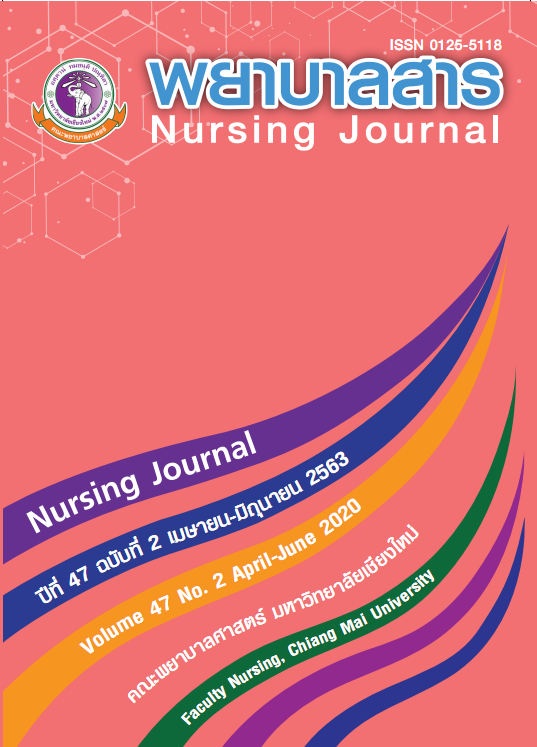Quality Improvement of Discharge Planning for Patients with Head and Neck Cancer, Eye Ear Nose and Throat Ward, Buddhachinaraj Phitsanulok Hospital
Keywords:
Quality Improvement, Discharge Planning, Patients with head and neck cancerAbstract
Discharge planning is the preparing for a patient before leaving the hospital in order to obtain continuous care. The objective of this study was to improve the quality of discharge planning of patients with head and neck cancer in Eye Ear Nose and Throat ward, Buddhachinaraj hospital, Phitsanulok, by using PDCA quality improvement process. The participants were 19 multidisciplinary teams, 23 patients with head and neck cancer who were operated on, and 23 caregivers. The study instruments developed by the researcher were 1) the focus group interview guidelines for multidisciplinary teams regarding the problems of discharge planning, 2) the interview guidelines for patients and caregivers regarding the needs of discharge, 3) the questionnaires for collecting problems and suggestions of discharge planning, 4) the ability assessment form of patients and caregivers in performing nursing activities which was modified from the questionnaire developed by Deawsurintr (1999), 5) the observation form for assessing the performance of multidisciplinary teams on discharge planning, 6) the satisfaction assessment form of patients and caregivers, and 7) the satisfaction assessment form of multidisciplinary teams regarding discharge planning. The quality of all instruments was confirmed by three experts. The Kuder–Richardson(KR-20) coefficient of the ability assessment form of patients and caregivers in conducting nursing activities was .89. Data was analyzed by using descriptive statistics.
The results revealed that: most of the multidisciplinary teams could completely perform the discharge planning for more than 80%, most of patients with head and neck cancer and their caregivers could completely perform nursing activities for more than 90%, patients with head and neck cancer were satisfied with the discharge planning at a high (69.57%) and the highest levels(30.43%), the multidisciplinary teams were satisfied with the discharge planning at a high (52.94 %) and the highest levels (47.06 %). This study showed good outcomes of discharge planning on the patient’s quality of life in which administrators should support the uses of discharge planning for other groups of patients.
References
Becker, M. H., & Maiman, L. A. (1980). Strategies for enhancing patient compliance. Journal of Community Health, 6 (2),113-135.
Boonmart, N. (2013). The quality improvement of discharge plan for chronic kidney di sease patients and families (Master’s thesis, Khon Kaen University). (In Thai)
Buddhachinaraj hospital, Phitsanulok. (2015). Annual report Eye Ear Nose and Throat Ward 2558. Phitsanulok: Buddhachinaraj hospital. (In Thai)
Deawsurintr, S. (1999). A Model development of discharge planning in head and neck can cerpatient (Master’s Thesis, Prince of Songkla University). (In Thai)
Geurgoolgijagan, N. (1998). Teaching patients in the hospital. Songkhla: Chanmuang Printing.(In Thai)
Haomachai, N. (2014). Development of discharge planning for low birth weight Infants at the infant intensive care unit of Srinagarind Hospital (Independent study, Khon Kaen University). (In Thai)
Khenshotgun, W., Srisanga, S., & Siripornadunsil, S. (2012). Discharge planning model development of patients with head and neck cancer at ENT Unit, Buriram Hospital. Journal of nurse Assosiation of Thailand, North-Eastern Division, 30 (3), 146-153. (In Thai)
Kunsawad, R .(2008). The development of discharge planning model for breast cancer p atients post-modefied radical mastectomy by multidisciplinary team in female surgical ward Khonkaen hospital (Independent study, Khon Kaen University). (In Thai)
Pichitponchai, W., & Udsadonwiset, U. (2002). Discharge planning concept and application. Bangkok: Faculty of Nursing, Mahidol University. (In Thai)
Promchan, P. (2009). The development of discharge planning model for intracerebral hemorrhage patient undergone surgery by multidisciplinary team , neuro surgical department, Udonthani Hospital (Independent study, Khon Kaen University). (In Thai)
Sawaengdee, K., Sathira-angkura, T., & Sirinakorn, R. (1996). Discharge planning. Bangkok: Printing Thammasat University. (In Thai)
Sirmala, S., Yenbut, J., & Urharmnuay, M. (2013). Discharge planning practices for preterm infants in neonatal intensive care unite, one of tertiary hospital, nor thern region. Nursing Journal Volume, 3(40), 21-29. (In Thai)
Strategy and Planning Division, Ministry of Public Health. (2017). Statistical Thailand 2017. Nontaburi: Stragtegy and Planning Division, Ministry of Public Health. (In Thai)
Downloads
Published
How to Cite
Issue
Section
License
บทความที่ได้รับการตีพิมพ์เป็นลิขสิทธิ์ของวารสารพยาบาลสาร
ข้อความที่ปรากฏในบทความแต่ละเรื่องในวารสารวิชาการเล่มนี้เป็นความคิดเห็นส่วนตัวของผู้เขียนแต่ละท่านไม่เกี่ยวข้องกับมหาวิทยาลัยเชียงใหม่ และคณาจารย์ท่านอื่นๆในมหาวิทยาลัยฯ แต่อย่างใด ความรับผิดชอบองค์ประกอบทั้งหมดของบทความแต่ละเรื่องเป็นของผู้เขียนแต่ละท่าน หากมีความผิดพลาดใด ๆ ผู้เขียนแต่ละท่านจะรับผิดชอบบทความของตนเองแต่ผู้เดียว






